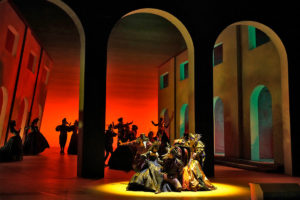
Los Angeles Opera 2017-18 Review – Rigoletto: Adela Zaharia Makes Triumphant Debut Alongside Michael Fabiano & Ambrogio Maestri
By Maria NockinOn Sunday, May 27, 2018, Los Angeles Opera presented Giuseppe Verdi’s “Rigoletto” with a new cast of singers that was equal to those who sang the premiere. For this unusual situation, I found it necessary to return to the City of Angels for another look. Having attended a matinee performance, I write about it as our car speeds eastward away from the pink and lilac sky of California recalling the many colors of Verdi’s music in their tuneful splendor.
Mark Lamos’s production, last seen at LA Opera in 2010, emphasized the duality of good and evil. When Rigoletto compared himself to Sparafucile, a professional killer, the audience began to realize that one causes injury with his knife and the other with his tongue. Despite his dark side, Verdi and librettist Piave have always managed to keep their audience rooting for the crippled jester.
Emphasis on Dark & Depraved With Taste
Lamos’s stage direction had changed somewhat from the May 12 premiere, and action that had occurred center stage was brought down front where the acoustics are better able to send the sound out front. Craig Colclough’s rendition of “Monterone’s Curse,” for example, was far more effective on this occasion.
The arches and walls of Michael Yeargan’s set seen on stage right slanted inward to indicate an abnormal situation. Rigoletto did not allow his daughter normal companionship. As a result, she was naïve enough to be duped by the Duke and she actually fell in love with him. Both Rigoletto’s apartment and Sparafucile’s home are similar box-like duplexes on stage left. They are workable but could be confusing to some viewers.
Constance Hoffman’s Renaissance costumes were attractive, detailed, and, in the case of some female courtiers, they even revealed rouged nipples. Thus, the decadence of the Mantuan court was never in question. Rigoletto’s comedy is just one more aspect of its debauchery. With a considerable hump on his back, the jester wore a traditional costume at court and dark clothing otherwise.
Most of the clothing that Sparafucile wore was as dark as his spirit, but his gloves shone bright red when Michael Wierzel’s lighting design hit them. Only the Duke wore a brightly colored outfit away from court.
Aucoin’s Potent Musical Direction
Conductor Matthew Aucoin, who had given the pre-performance lecture, kept his orchestra moving at a lively pace, so much so that the Duke had to catch up when he entered the first scene. Aucoin has an excellent interpretation of traditional Verdi. His orchestra emphasized the score’s drama when Gilda was abducted and its pathos when her father finds her. At the very end, Maestro Aucoin had his ensemble play forte as Gilda sang in full voice that she still loved the Duke. It showed not only the drama in the orchestra, but Adela Zaharia’s ability to sing over a more than fifty-piece orchestra.
The tuneful “La donna è mobile” and the chorus of courtiers provided moments of levity and musical delight even though we knew its text was merely a libertine’s defense for his character flaw. When the Duke sang it in the last act, Maddalena’s retorts told the audience that the average Mantuan knew what was going on at court.
Lots of Vocal Talent
A new face at LA Opera, Adela Zaharia won first place in the 2017 Operalia Contest. She is a different kind of Gilda from the previous portrayer in LA. Her voice has the necessary high extension but her tones are stronger and more dramatic than usual. Her sound is darker and she has a more interesting timbre than most coloratura singers. The colors and dramatic aspect of her voice were most apparent in the last act before she was stabbed. She easily sang over the full orchestra playing forte.
Michael Fabiano was a devil-may-care aristocrat who swaggered across the stage as though he was the most important person in his realm; his interpretation seemed to be “The world revolves around me.” On Sunday, he sang with glinting lyrical sound and clear diction. His tones were more focused than in the past and most of the time he hit each note right in its center.
Ambrogio Maestri was a mountain of a man singing a mountainous role. Physically, he towered over the Duke to whom he owed his livelihood, but then so did the assassin, Sparafucile. Theirs was the vain attempt of physical power to overthrow political supremacy. Ambrogio sang with well-rounded dark tones and a certain degree of vulnerability that allowed the audience to feel his pain. He seemed to completely collapse when he realized that it was Gilda in the sack.
Morris Robinson, the Sparafucile, was the only major cast member who was not replaced for the last set of performances. It would be very hard indeed to replace such a bass and his mellifluous low tones dominated the stage whenever he strode it.
Ginger Costa-Jackson was a sexy Maddalena who never fell for the Duke’s attempts at seduction. She sang this less-than-grateful role with the dark sounds it calls for. She and Maestri were the steady, low voices balancing a well-crafted quartet that allowed soprano and tenor to shine brightly.
Liv Redpath was a cheeky Countess Ceprano who knew how to play with the Duke. Joshua Wheeker and Juan Carlos Heredia were sprightly courtiers who danced to the Duke’s tunes while Sharmay Musacchio and Michelle Siemens as Giovanna and the Page barely managed to find their way out of trouble.
It is always interesting to see what becomes of a production when it has been performed a few times. Reviewers are usually asked to see it on its first night and never given the chance to view it again. I appreciated this opportunity and recommend that operagoers who saw the first cast return to see the changes equally talented artists have made.


